Growing up in a Filipino household, Pancit Guisado wasn't just another noodle dish, it was the centerpiece of every birthday celebration and family gatherings.
This classic Filipino stir-fried noodle dish, with its perfect harmony of tender rice noodles, succulent meats and crisp vegetables, carries the cherished belief that its long strands bring long life to those who eat it.
Through years of perfecting this recipe in my own kitchen, I've captured the authentic flavors that make this dish a beloved staple in Filipino cuisine, from the subtle umami of the soy sauce to the bright finish of fresh calamansi.
This time-tested recipe transforms simple ingredients into a feast that's both comforting and impressive, ideal for both special occasions and everyday meals. My detailed guide will help you create a Pancit Guisado that rivals the best traditional versions, complete with that distinctive wok hei flavor that makes this dish truly unforgettable.
This pancit guisado recipe has never failed to bring smiles to faces and second helpings to plates.
Jump to:
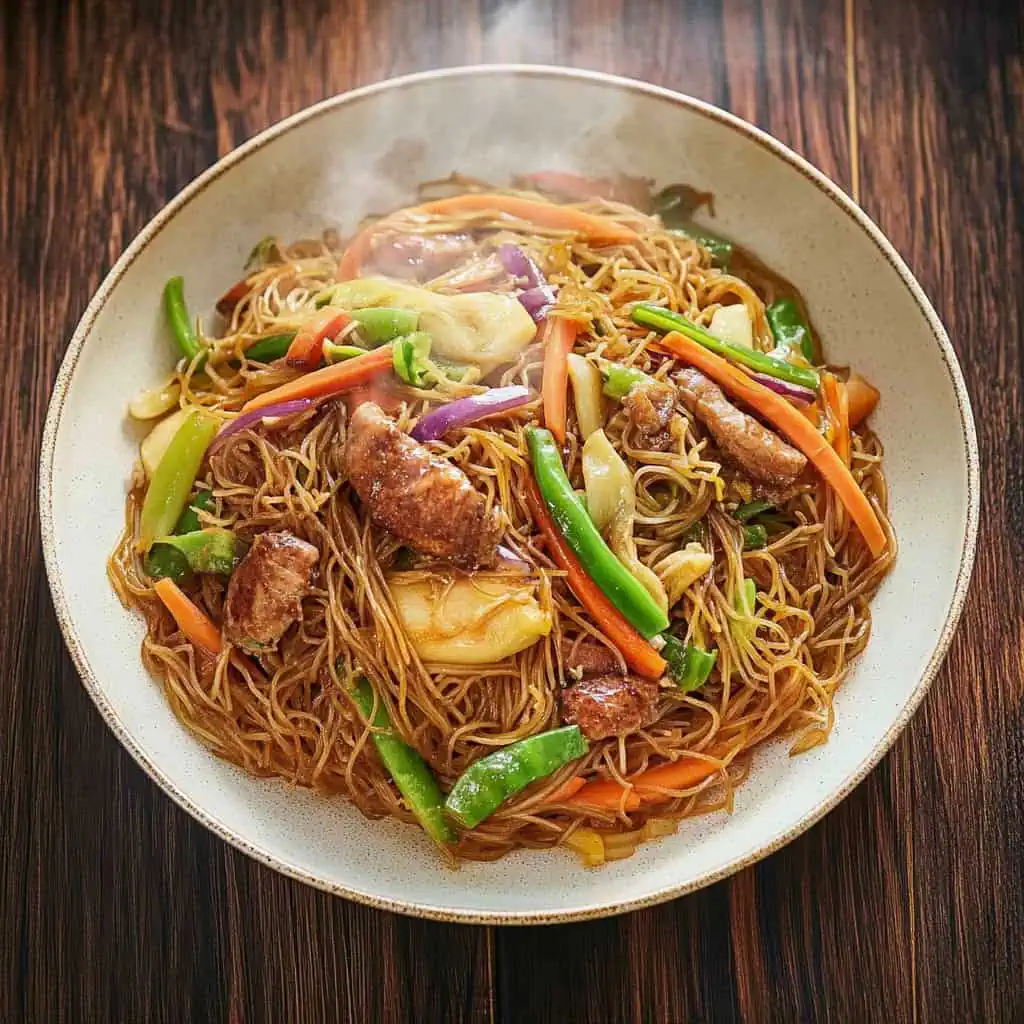
Why You'll Love This Recipe
- Quick weeknight dinner - ready in just 30 minutes
- One-pan meal with minimal cleanup
- Customizable with your favorite proteins and vegetables
- Perfect balance of textures and flavors
- Authentic Filipino taste that's better than takeout
- Budget-friendly yet impressive enough for special occasions
- Great for meal prep - keeps well and reheats beautifully
Ingredients
These ingredients create the perfect harmony that makes Pancit Guisado special. The rice noodles form a light, delicate base that absorbs the savory flavors from the chicken stock and soy sauce. The protein trio (chicken, shrimp, and Chinese sausage) provides different layers of savory goodness, while the colorful vegetables add freshness, texture, and nutrition.
Aromatics like garlic, onion, and celery build a fragrant foundation, and the finishing touch of calamansi brings a bright, citrusy note that balances the rich umami flavors and ties everything together.
Each ingredient plays an essential role in creating this beloved Filipino classic.
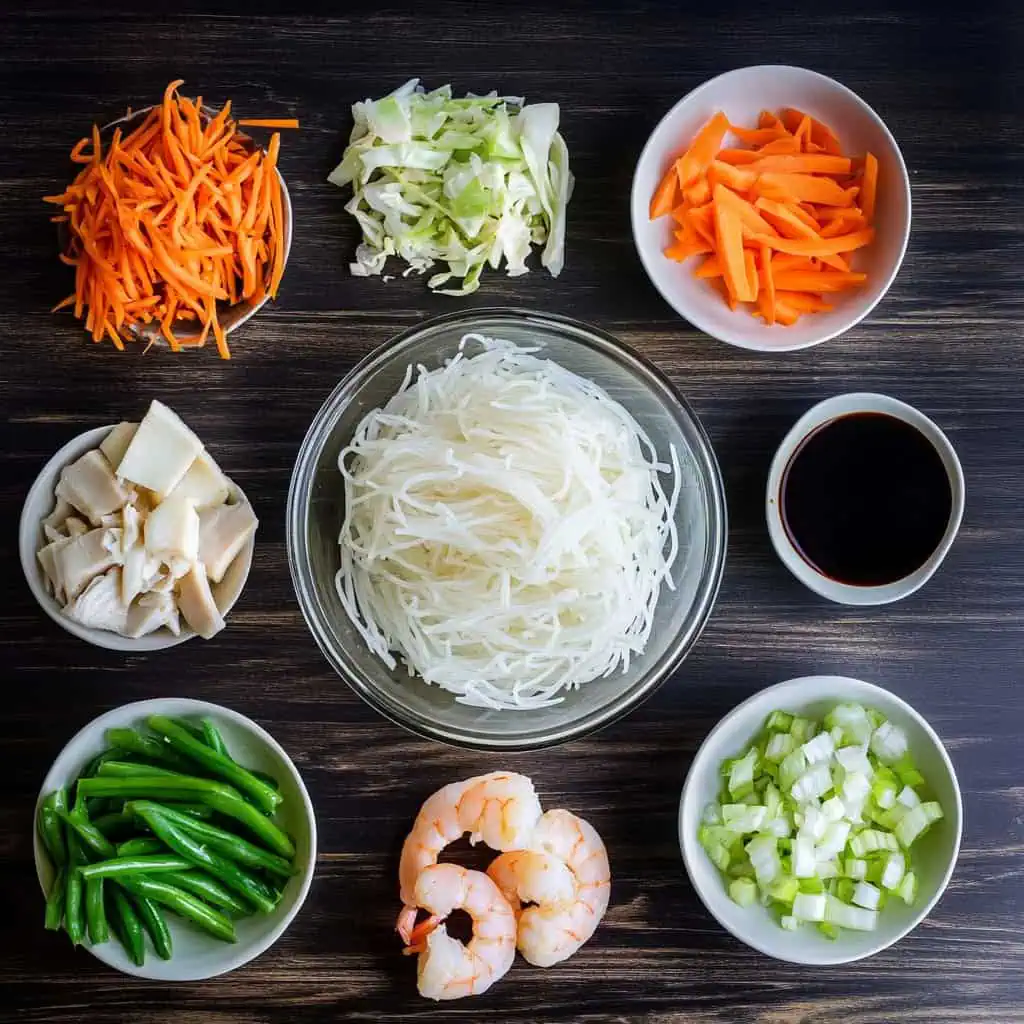
For the Noodles and Proteins:
- 500g rice noodles (bihon), soaked and drained
- 300g chicken thighs, boiled and shredded
- 200g shrimp, peeled and deveined
- 2 pieces Chinese sausage (chorizo macau), sliced diagonally
- 1 Knorr shrimp cube or chicken bouillon
For the Vegetables:
- 2 cups cabbage, chopped
- 1 cup carrots, julienned
- 1 cup green beans, cut into 2-inch lengths
- 1 medium onion, sliced thinly
- 6 cloves garlic, minced
- 2 stalks celery, chopped
- ½ cup parsley, chopped
For the Sauce:
- 5 tablespoons dark soy sauce
- 4 tablespoons cooking oil
- Ground black pepper to taste
- 4 cups chicken stock or water
For Serving:
- Calamansi limes
- Extra chopped parsley
- Chili garlic sauce (optional)
Equipment
- Large wok or kawali (deep pan) - For even heat distribution and enough space to toss ingredients without spilling
- Sharp knife and cutting board - For precise vegetable cuts that cook evenly
- Kitchen tongs - Essential for tossing noodles gently without breaking them
- Colander - For properly draining the soaked noodles
- Measuring cups and spoons - For accurate portions and balanced flavors
- Wooden spoon - For sautéing ingredients without scratching your cookware
- Small bowls - For organized mise en place (ingredient preparation)
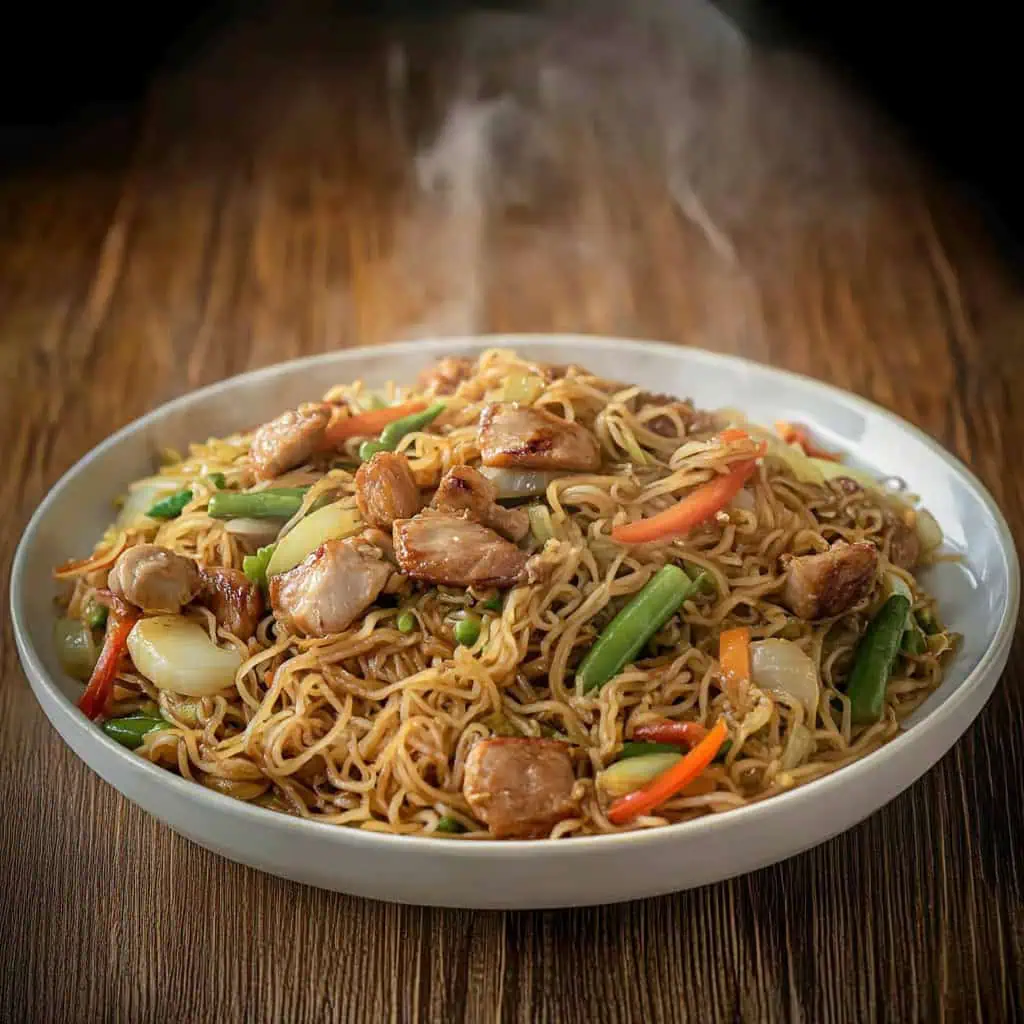
How To Make
- Begin by soaking rice noodles (bihon) in room temperature water (27°C/80°F) for 8-10 minutes until pliable but not too soft. Drain and set aside. During this time, prepare and organize all vegetables (mise en place).
- Heat cooking oil in a wok or kawali over medium-high heat (180°C/350°F). Pan-fry shrimp for 1 minute per side until pink. Remove and set aside. In the same pan, brown Chinese sausage slices until lightly crisp.
- Lower heat to medium (160°C/320°F). Sauté minced garlic until fragrant, then add sliced onions and cook until translucent. Add shredded chicken and chopped celery. Crumble in the shrimp cube and stir well to combine.
- Increase heat to medium-high (180°C/350°F). Add julienned carrots and cut green beans, cooking for 2 minutes. Add chopped cabbage and stir-fry for 1 minute until slightly wilted.
- Add the drained noodles to the wok. Pour in soy sauce and chicken stock, gently tossing with tongs until the noodles absorb the liquid. Return cooked shrimp to the pan. Season with black pepper and add chopped parsley. Continue tossing until well combined and noodles are cooked through, about 3-5 minutes.
- Serve hot with calamansi halves on the side for squeezing over the dish.

Tips from Lola's Kitchen
- Pre-flavor your proteins: Boil chicken with ginger, onions, and peppercorns for a deeper flavor base.
- Respect the noodle: Handle rice noodles gently and avoid overworking them to prevent breaking.
- Keep everything moving: Constant tossing prevents ingredients from sticking to the pan and ensures even cooking.
- Gradual liquid addition: If noodles are too dry, add stock little by little rather than all at once.
- Consistent cutting: Keep vegetable pieces similar in size for uniform cooking time.
- Temperature matters: Make sure your wok is hot enough before adding proteins to achieve that perfect sear.
- Add calamansi at the table: Squeezing fresh calamansi just before eating preserves its bright citrus notes.
- Judge your noodle soak: The perfect soak time varies with ambient temperature and noodle brand—look for pliable but not soft texture.
Substitutions
- Chicken: Use pork belly, beef strips, or firm tofu for vegetarian options
- Shrimp: Substitute with fish cake, calamari rings, or more chicken if seafood isn't available
- Chinese sausage: Bacon, ham, or even sweet Spanish chorizo can work in a pinch
- Green beans: Snow peas, sugar snap peas, or asparagus cut into small pieces
- Dark soy sauce: Regular soy sauce will work (use slightly less and consider adding a touch of sugar for color)
- Calamansi: Lemon or lime juice mixed with a tiny bit of orange juice approximates the flavor
- Chicken stock: Vegetable stock or even water with extra bouillon for vegetarian versions
- Parsley: Cilantro or green onions make excellent alternatives
Troubleshooting
- Noodles too soft: You've likely soaked them too long or overcooked them. Next time, reduce soaking time and toss them in the wok for less time.
- Noodles too hard or dry: Add a splash more chicken stock or water, cover the wok for 1-2 minutes to steam, then toss again.
- Vegetables too crunchy: Cover the wok briefly to create steam that will soften vegetables without overcooking the noodles.
- Dish too salty: Add a squeeze of calamansi juice to balance the saltiness, or quickly toss in a small amount of unseasoned cooked noodles.
- Not flavorful enough: Add another half shrimp cube or a splash more soy sauce, but do this before the noodles have fully absorbed the liquid.
- Noodles clumping together: Make sure to drain soaked noodles well and add them to the hot wok in smaller batches if needed, tossing constantly.
- Too much liquid: Continue cooking uncovered, tossing frequently until excess liquid evaporates.
Storage & Reheating
- Refrigeration: Store in an airtight container for up to 3 days. The flavors often improve overnight as they meld together.
- Freezing: While possible for up to 1 month, freeze without vegetables for best texture. Thaw in refrigerator overnight.
- Wok reheating: The best method—heat a tablespoon of oil in a wok, add pancit, and toss with a splash of water or stock to revive moisture.
- Microwave method: Cover with a damp paper towel and heat in 30-second intervals, stirring between each until hot (about 2-3 minutes total).
- Freshening tips: Add fresh herbs, a squeeze of calamansi, and a drizzle of sesame oil after reheating to restore vibrant flavors.
- Portion control: If making for meal prep, slightly undercook noodles initially so they don't become mushy when reheated.
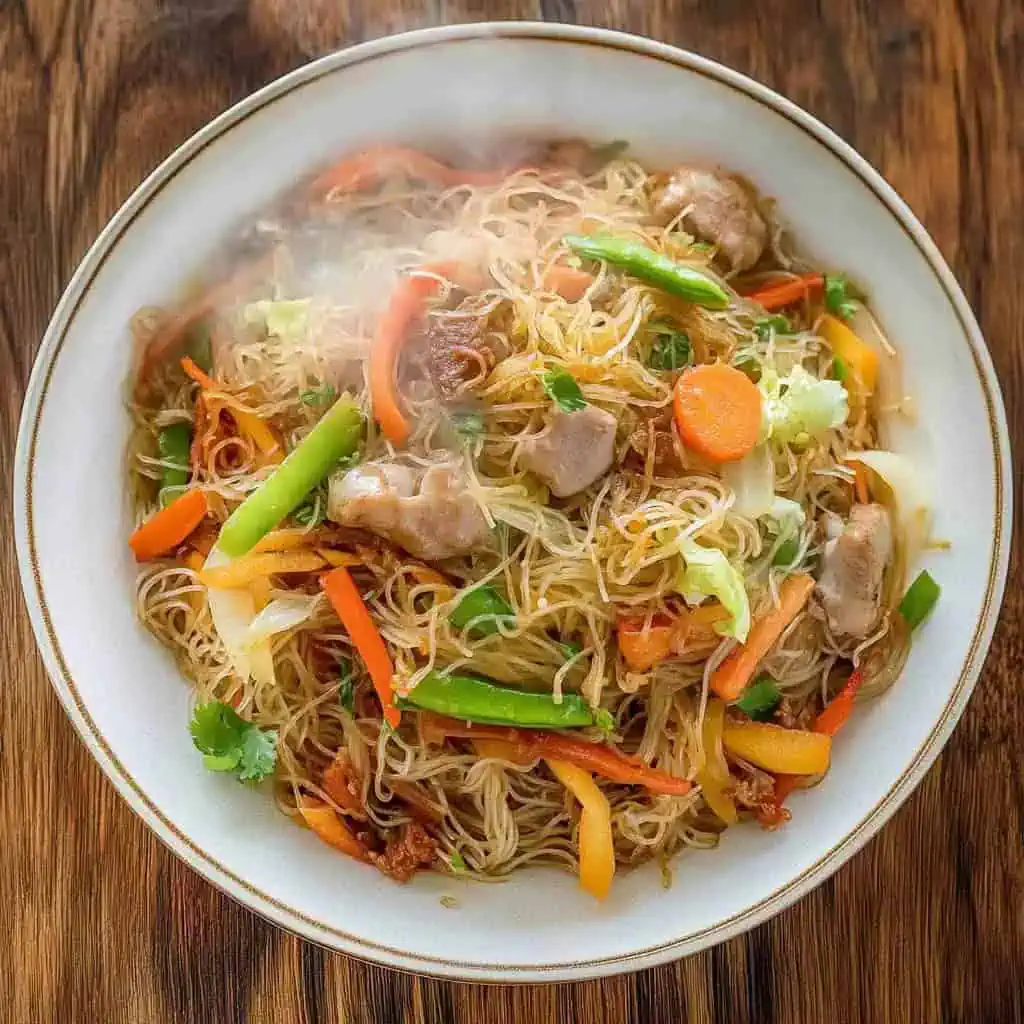
FAQ
Can I prepare this dish in advance for a party?
Yes! You can prepare it up to a day ahead. Slightly undercook the noodles and vegetables, then reheat in a wok with a splash of stock before serving. Add fresh garnishes just before serving.
How do I prevent my noodles from clumping or breaking?
Don't soak noodles for too long, they should be pliable but still slightly firm. Use tongs instead of a wooden spoon for gentler handling, and keep the noodles moving constantly once they're in the wok.
Is this recipe gluten-free?
Not as written, but it can easily be made gluten-free by using tamari or certified gluten-free soy sauce instead of regular soy sauce, and ensuring your bouillon cube is gluten-free.
Can I use other types of noodles if rice noodles aren't available?
Yes, you can use egg noodles (pancit canton) or even thin vermicelli, but cooking times and liquid amounts will vary. Rice noodles give the most authentic result.
How spicy is this dish traditionally?
Pancit Guisado is typically mild, allowing the savory flavors to shine. Serve chili garlic sauce on the side so everyone can adjust the heat to their preference.
What's the best protein combination for authentic flavor?
The chicken-shrimp-Chinese sausage combination is traditional, but many Filipino families have their own variations. The most important thing is to have at least one protein that contributes umami (like chicken or pork).
Should I rinse the noodles after soaking?
A quick rinse helps remove excess starch that might make noodles sticky, but don't rinse too much or you'll wash away flavor-absorbing starches.
What makes Pancit Guisado different from other Filipino pancit dishes?
Pancit Guisado specifically refers to the stir-frying method. It most commonly uses rice noodles (bihon), while other variants like Pancit Canton use egg noodles, and Pancit Malabon uses thick rice noodles with a sauce rather than a stir-fry method.
Related
Looking for other recipes like this? Try these:
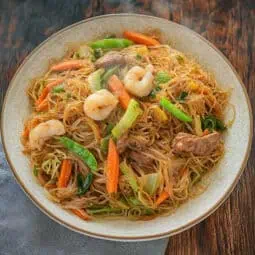
Pancit Guisado (Pancit Bihon Gisado)
Equipment
- Large wok or kawali (deep pan) for even heat distribution
- Sharp knife and cutting board (kutsilyo at sangkalan) for precise vegetable cuts
- Kitchen tongs (Sipit) for tossing noodles without breaking them
- Colander (salaan) for draining noodles
- Measuring cups and spoons (Panukat) for accurate portions
- Wooden spoon (sandok na kahoy) for sautéing without scratching pan
- Small bowls (mangkok) for ingredient preparation
Ingredients
For the Noodles and Proteins
- 500 g rice noodles bihon, soaked and drained
- 300 g chicken thighs hita ng manok, boiled and shredded
- 200 g shrimp hipon, peeled and deveined
- 2 pieces Chinese sausage chorizo macau, sliced diagonally
- 1 Knorr shrimp cube or chicken bouillon
For the Vegetables
- 2 cups cabbage repolyo, chopped
- 1 cup carrots karot, julienned
- 1 cup green beans sitaw, cut into 2-inch lengths
- 1 medium onion sibuyas, sliced thinly
- 6 cloves garlic bawang, minced
- 2 stalks celery kinchay, chopped
- ½ cup parsley wansuy, chopped
For the Sauce
- 5 tablespoons dark soy sauce toyo
- 4 tablespoons cooking oil mantika
- Ground black pepper paminta to taste
- 4 cups chicken stock or water
For Serving
- Calamansi limes kalamansi
- Extra chopped parsley
- Chili garlic sauce optional
Instructions
- Begin by soaking rice noodles (bihon) in room temperature water (27°C/80°F) for 8-10 minutes until pliable but not too soft. Drain and set aside. During this time, prepare and organize all vegetables (mise en place).
- Heat cooking oil (mantika) in a wok or kawali over medium-high heat (180°C/350°F). Pan-fry shrimp (hipon) for 1 minute per side until pink. Remove and set aside. In the same pan, brown Chinese sausage (chorizo macau) slices until lightly crisp.
- Lower heat to medium (160°C/320°F). Sauté minced garlic (bawang) until fragrant, then add sliced onions (sibuyas) and cook until translucent. Add shredded chicken and chopped celery (kinchay). Crumble in the shrimp cube and stir well to combine.
- Increase heat to medium-high (180°C/350°F). Add julienned carrots and cut green beans (sitaw), cooking for 2 minutes. Add chopped cabbage (repolyo) and stir-fry for 1 minute until slightly wilted.
- Add the drained noodles to the wok. Pour in soy sauce (toyo) and chicken stock, gently tossing with tongs until the noodles absorb the liquid. Return cooked shrimp to the pan. Season with black pepper (paminta) and add chopped parsley (wansuy). Continue tossing until well combined and noodles are cooked through, about 3-5 minutes.
- For reheating, warm over medium heat (160°C/320°F) with a splash of water. Serve hot with calamansi (kalamansi) halves on the side.
Tips from Lola's Kitchen
- Prepare chicken ahead: boil with ginger and peppercorns for more flavor
- Don't overwork the noodles to prevent breaking
- Keep ingredients moving in the pan to prevent sticking
- If noodles are too dry, add stock gradually, not all at once
- Cut all vegetables similar in size for even cooking
- Add kalamansi juice just before eating, not during cooking
Nutrition
The Story Behind Filipino Pancit Guisado
Pancit Guisado's journey to becoming a Filipino culinary icon began in the bustling streets of pre-colonial Manila, where Chinese merchants first introduced rice noodles to local cuisines. The word "pancit" itself comes from the Hokkien term "pian e sit," meaning "something conveniently cooked" – a nod to the dish's origins as a quick, satisfying meal for traders and workers in Manila's growing Chinese communities.
What makes Filipino Pancit Guisado distinct from its Chinese ancestors is the ingenious adaptation of local ingredients and cooking methods. While Chinese noodle dishes often relied on subtle seasonings, Filipino cooks boldly incorporated native calamansi, transformed soy sauce proportions, and added local vegetables to create a uniquely Filipino flavor profile. The addition of Chinese sausage (lap cheong) alongside native proteins showcases the beautiful marriage of both culinary traditions.
Perhaps most significantly, Pancit Guisado evolved beyond mere sustenance to become deeply woven into Filipino cultural fabric. The long, unbroken noodles came to symbolize long life and good fortune, making the dish an essential presence at birthday celebrations. This symbolism wasn't just adopted – it was embraced so thoroughly that many Filipinos consider a birthday celebration incomplete without a steaming plate of pancit on the table.
Today, Pancit Guisado reflects the Philippines' rich history of cultural adaptation and innovation. Each region has developed its own variation, from Malabon's seafood-rich version to Lucena's addition of local vegetables. Yet the basic elements – the tender rice noodles, the harmonious blend of proteins, and that distinctive savory sauce – remain constant, connecting modern Filipino families to generations of tradition and celebration.
The dish has transcended its humble origins to become a powerful symbol of Filipino hospitality and family bonds. Whether served at grand celebrations or quiet family dinners, Pancit Guisado continues to bring people together, carrying with it the wishes for prosperity, longevity, and the warmth of shared meals that define Filipino culture.
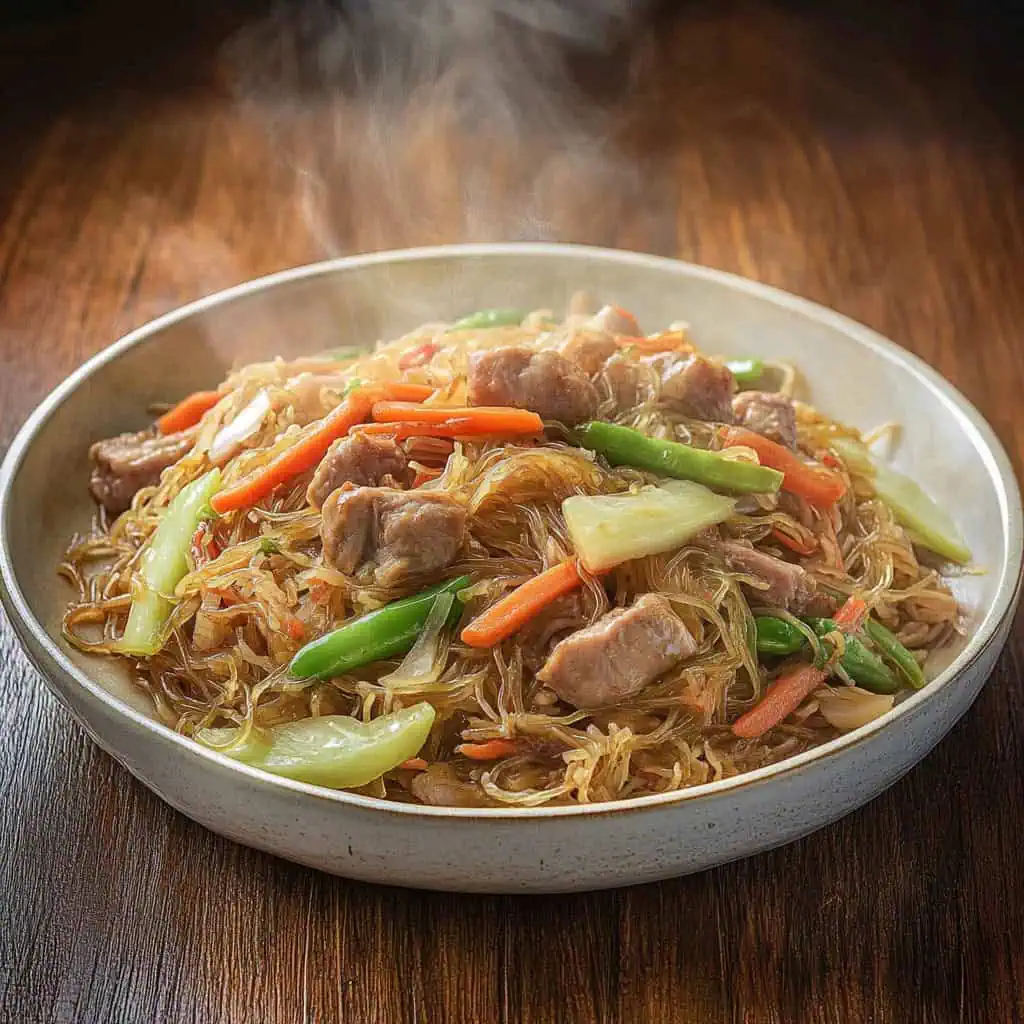





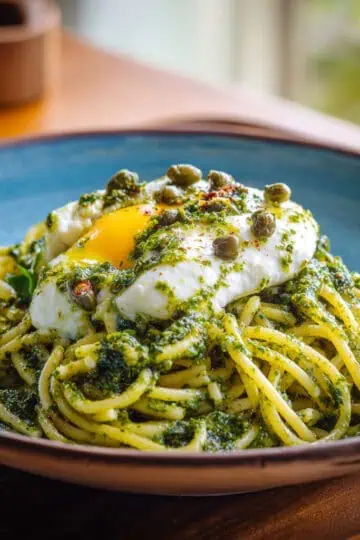
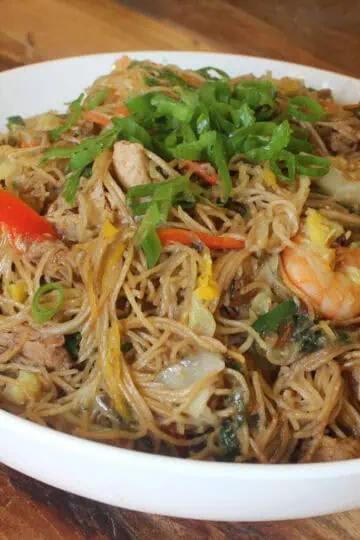
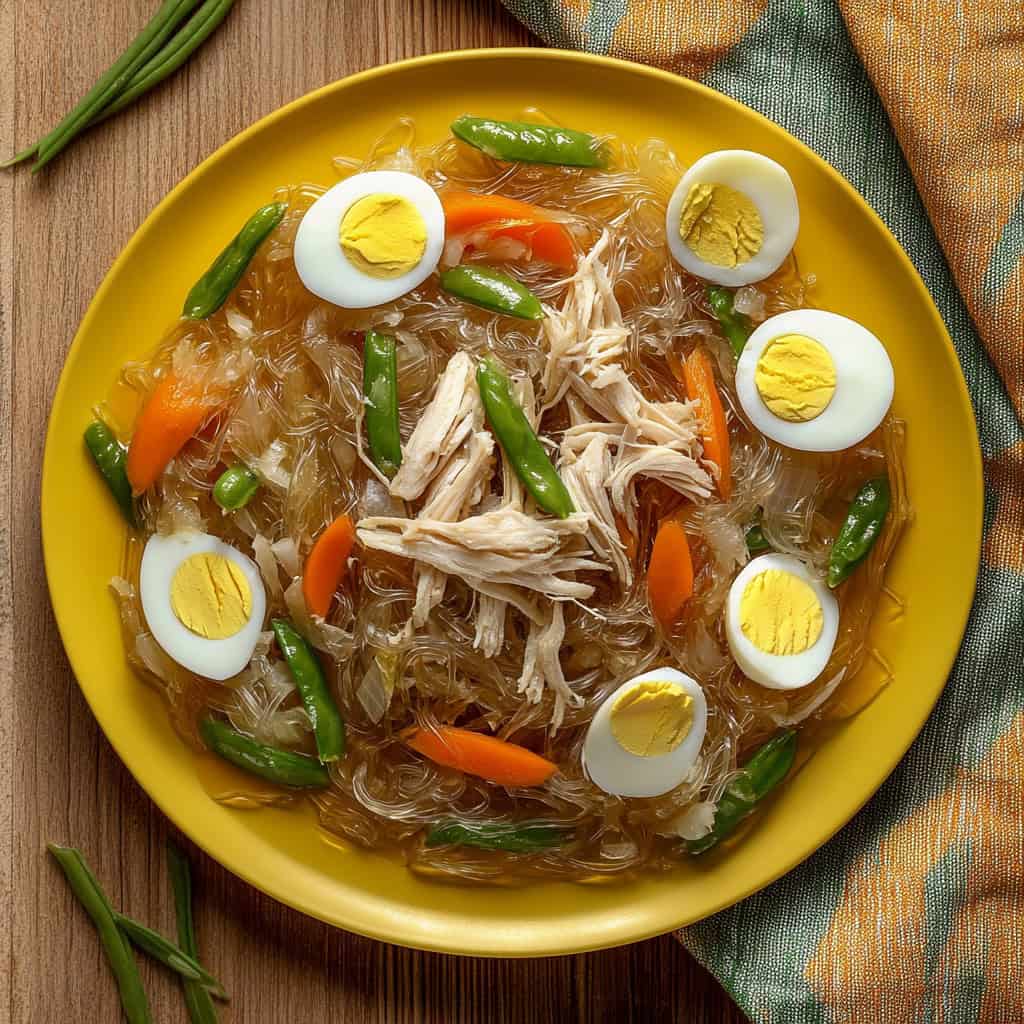
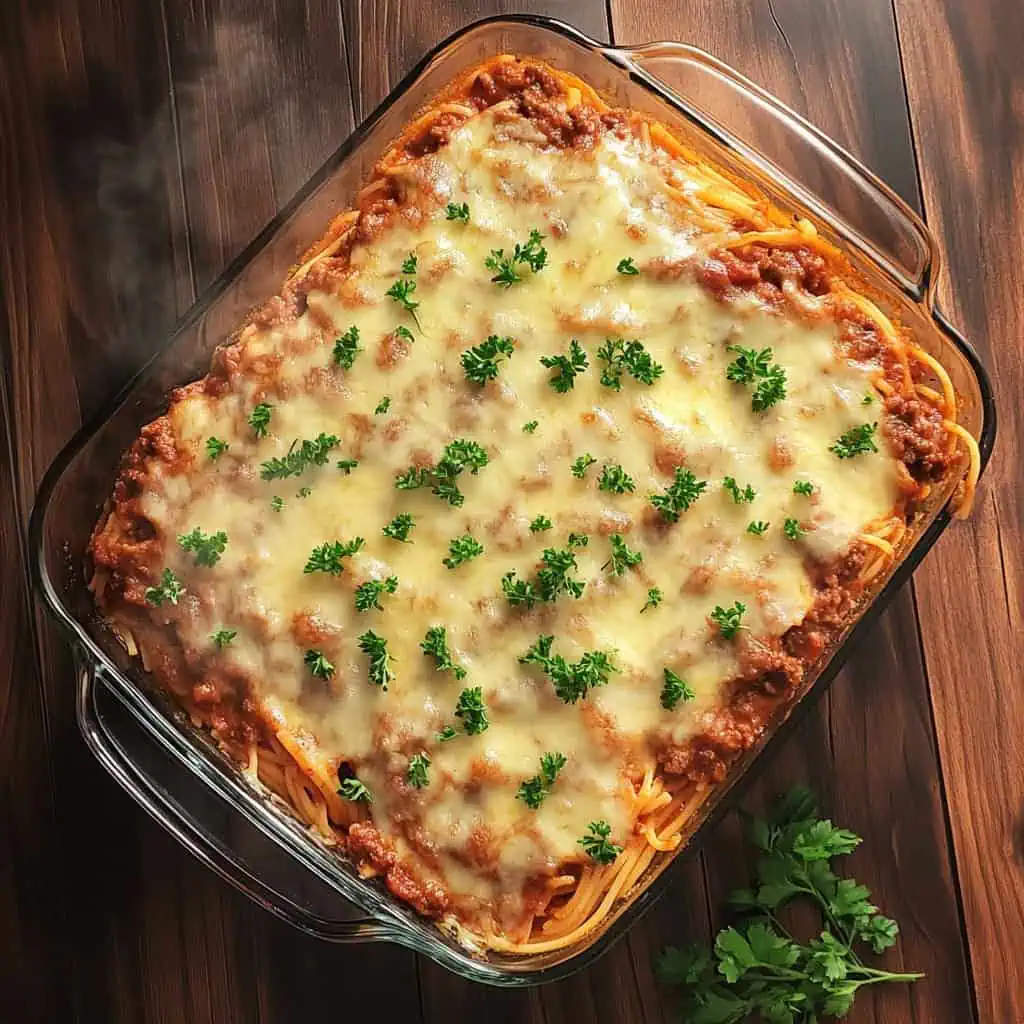
Comments
No Comments